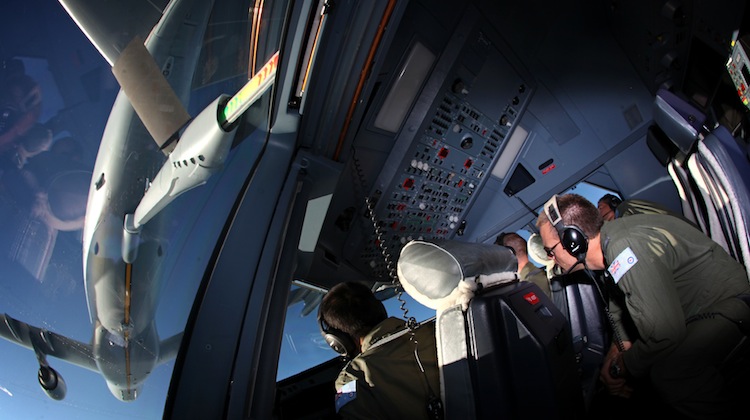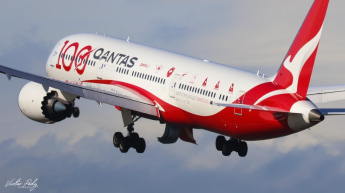
Two KC-30A crews have completed the first boom contact by the aircraft in RAAF service.
The first KC-30’s crew deployed the 17-metre-long Aerial Refuelling Boom System (ARBS) to make 14 successful contacts with the refuelling receptacle of a second KC-30 during a three-hour flight out of RAAF Base Amberley southwest of Brisbane on May 13.
No fuel was transferred between the aircraft.
The Defence Materiel Organisation (DMO) stated in March that the KC-30 project – AIR 5402 – had been removed from the Projects of Concern list, after an extensive development and testing program led to issues that were previously identified with the introduction of the ARBS being resolved.
“More training flights are being flown to ensure aircrew are experienced with the operation of the ARBS,” said Air Vice-Marshal Gavin Turnbull, Air Commander Australia. “We will shortly begin training flights with the KC-30A using its ARBS to refuel the E-7A Wedgetail.
“The KC-30A has already been cleared to refuel other aircraft in flight with its hose-and-drogue refuelling pods, which are mounted beneath the wings. The refuelling pods have been used to great effect in Operation OKRA by refuelling RAAF Hornets and Super Hornets over Iraq, as well as coalition strike aircraft.”
The ARBS is capable of offloading fuel at a rate of 4,500 litres per minute, and is also compatible with the C-17 Globemaster. In the future, the boom will be used to refuel the F-35 Lightning II and P-8 Poseidon.















Peter B
says:A landmark achievement in RAAF history and capability. At the other end of the spectrum, I wonder if a KC130 or KC-27 variant will eventually serve as refueller for Army helos, either air to air or as a fuel source at forward bases. Army aviation needs to expand to meet the needs of plan Beersheba and to exploit the new amphibious ships – tactical KC type aircraft will serve as force multipliers for Army aviation.
Allan
says:Top photo, It will be good to see other aircraft on the boom over the coming months.
Chris G
says:I concur with Peter B that 8-10 C17A in RAAF service will allow reutilisation of some Hercules as KC130J30s for which they are already plumbed. Besides external pods and tanks either a probe or UARSI are required on the tankers themselves. All the ADF would benefit from this capability, not just the Army.
i would also like to ack Carlo KOPPs past efforts in AA to educate others about tanker ratios being critical to capability. Fighter numbers are only part of the AWACS, EW, MPA and MRTT mix required to mount and sustain successful ops.
Michael
says:Chris thanks. I wasn’t aware the C-130s were already plumbed as tankers. I was advocating in another article buying RORO probe/drogue kits for use on C-130s and maybe C-27s, similar to what is being developed for the Osprey.
I wonder how expensive it would be to equip our Hercs with wing pods and UARSI?
Raymond
says:Could a link supporting RAAF C-130Js already being plumbed as tankers be provided please?
John N
says:Great to see the KC-30A getting closer to FOC, it’s been a long long road, but worth the wait!
As to a KC-130 or a KC-27, what is the point? Seriously, what is the point?
The simple facts are that no helicopters in ADF service are equipped, or a planned to be equipped for aerial refuelling, why waste scares Defence budget dollars on that sort of capability?
By the mid 2020’s the only AAR equipped aircraft in ADF service the that would require a hose and drogue system will be the 36 Super Hornets and Growlers, on the other hand the other approx. 100 airframes equipped and capable of AAR, eg, F-35A, E-7A, P-8A, KC-30A, C-17A, all require the boom system.
What the ADF does need is for the KC-30A fleet to be expanded to at least 8 airframes, which would be consistent with the original plan, 5 + 3 options, options that were never exercised, options that should be restored (the previous Def Min did hint last year that another two KC-30A’s were potentially on the cards, just have to wait for the new DWP for confirmation either way).
The one exception to my remarks about KC-130’s or KC-27’s, would be if and I repeat ‘if’ the Government eventually procured a squadron of MH-47G’s for use by the Special Forces, then yes, one or two aircraft configured for AAR would be appropriate to support those probe equipped MH-47G’s, otherwise it is still a wasted effort and a waste of scares Defence dollars.
Cheers,
John N
Michael
says:Hi John N.
I’m not sure about others but the only situation I was envisioning in which tanking capability would be acquired for the C-130s or C-27s, would be just like you are saying, if the ADF were to acquire a probe equipped special ops chopper like the MH-47G.
I think a spec ops chopper like the MH-47G combined with adequate tanking capability would provide the ADF with quiet a powerful deterrent and provide the government with another option on the table in the event us or our interests were threatened.
Weighing that up though against acquiring more Kc-30s, I think having more KC-30s provides greater overall capability and deterrent value for the ADF. The budget can only stretch so far. However, I’m sure there are those in the Russell Offices that have a better idea as to what is best than what I do. 🙂
Raymond
says:Thanks John N for your contributions – always valued.
Just one thing… I think your use of the word ‘scares’ twice is actually meant to be ‘scarce’?
Cheers